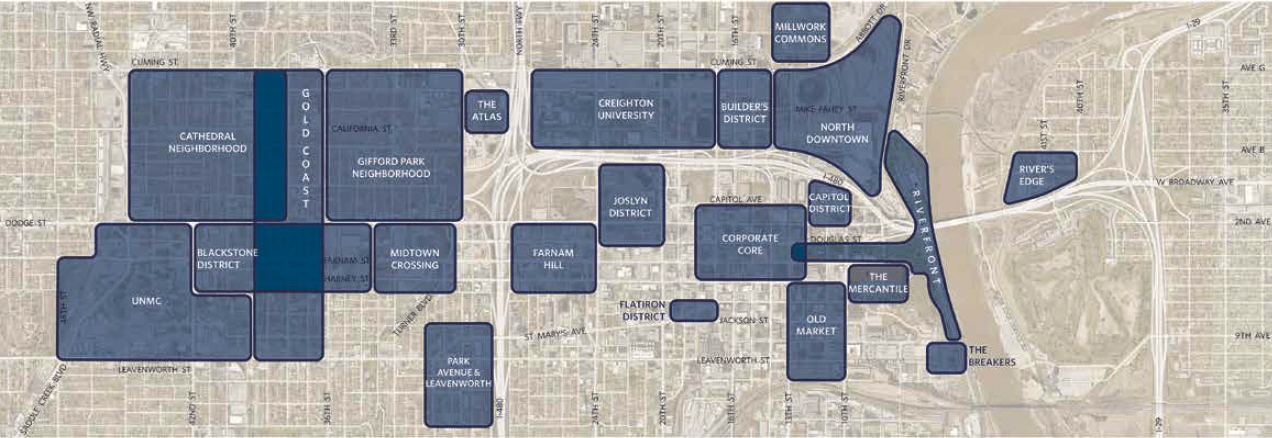The Urban Core Committee recently revealed the Urban Core Strategic Plan to guide future developments within Omaha’s oldest and densest neighborhoods. The plan deserves the attention of people who want to understand how things will progress in our urban core and how we can grow sustainably for current and future generations.
It’s no surprise that Omaha heavily supports suburban development. Our current master plan and zoning rules do not restrict the growth of suburban neighborhoods, and it does not strategically plan for them. This is left up to the interest of developers who purchase large acreages, extend sewer and electricity, build roads, and construct homes. These developments would not happen without residents interested in suburban lifestyles. But more recently, Omaha residents want more options for non-suburban lifestyles.
Everyone has a preference for the lifestyle they pursue. The Urban Core Strategic Plan addresses people who want urban neighborhoods for a high quality of life. These residents deserve to have their wants and needs addressed like our suburban neighbors.
A few types of residents who prefer the urban core:
Individuals and families who own a car and do not want to use it for every aspect of life. The option of using another form of transportation (walk, bike, etc.) is their desire. Whether a family is walking to get ice cream post-dinner or a person is meeting friends for drinks and does not want to drive after, we have limited options for doing these things without a car. Omaha needs more neighborhoods with commercial nodes to support businesses and transportation preferences.
Individuals and families who do not like owning a car. Their preference may be biking, transit, or walking as primary transportation. This could be because they want to lessen their carbon footprint, or maybe they moved from a community where a car was optional and chose to not own one. We also have residents who struggle to own and upkeep a car financially. These residents and families still need to get around for work, school, appointments, errands, etc., and Omaha is extremely difficult for residents who do not own a car.
- Our transplant and boomerang workforce. While working with the Greater Omaha Young Professionals program, a survey revealed that most residents under 40 who lived in Omaha their entire life preferred suburban neighborhoods. However, there are two groups of young professionals who prefer urban areas: 1) Individuals who moved to Omaha with no community ties for reasons such as job opportunities or to relocate with their spouses, and 2) individuals who moved away from Omaha for various reasons and decided to come back and live. If we solely support suburban growth, Omaha will not appeal to these individuals, and they will leave to find their ideal quality of life.
Three takeaways from the Urban Core Strategic Plan:
The plan transforms our approach to streets and interstates. It recognizes that the massive push for interstate developments for 40 years negatively impacted our urban core. Interstates quickly push a substantial number of cars from one area to another while bypassing the neighborhoods they are located in. Businesses receive fewer customers, and placing an interstate system throughout downtown resulted in people visiting for work and then quickly returning home. Here are the recommendations to address this:
- Removing underutilized on and off interstate ramps
- Placing lids over sections of the interstate to maximize land and connect neighborhoods that were previously split
- Building a bike/pedestrian/transit bridge from downtown Omaha to Council Bluffs
The plan is innovative. It realizes technology will continue to advance, and we must consider new ways of life for Omaha to remain relevant. Existing cities around our country are piloting infrastructure for autonomous vehicles. Different modes of transit also allow residents under the driving age to have the independence to get around. Here are the recommendations:
- Creating routes for autonomous shuttle connectors
- Launching a streetcar system to circulate the urban core
There is more connectivity. The neighborhoods east of Interstate 480 are blighted, meaning there is excessive vacant land and substandard buildings. Our city’s planning policies allowed this to happen, and we must be intentional about building these areas up. As more housing developments and commercial nodes are constructed, our urban core will become a vibrant place for residents who prefer this lifestyle. Walkable neighborhoods that are continuous become less of a liability and more of an asset for our neighbors.
If you’d like to view the entire Urban Core Strategic Plan, here is a link to the 105-page document. You do not have to read it thoroughly, but the information you can catch while skimming through it is worthwhile.
Lastly, if you live in a neighborhood located in the urban core, please become familiar with the resources of One Omaha. We support you and your neighbors by assisting with engagement to create strong and safe neighborhoods that represent a shared vision.
This blog was written by Alexis Bromley, executive director of One Omaha. Alexis can be reached at alexis@oneomaha.org.

